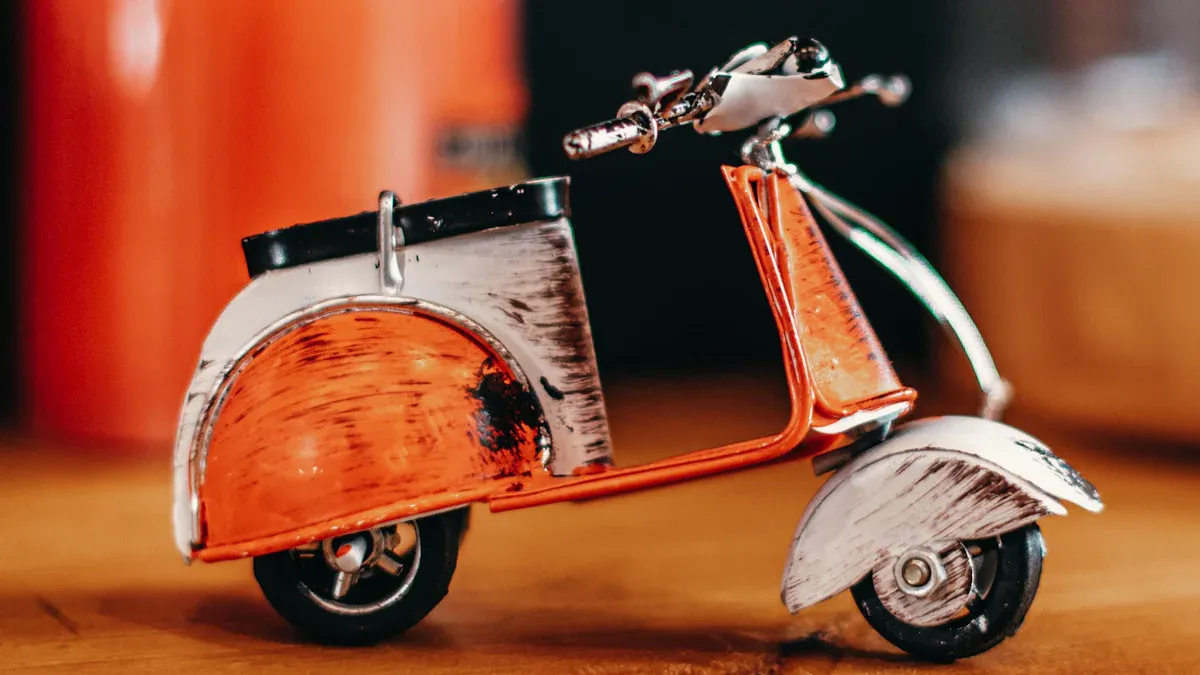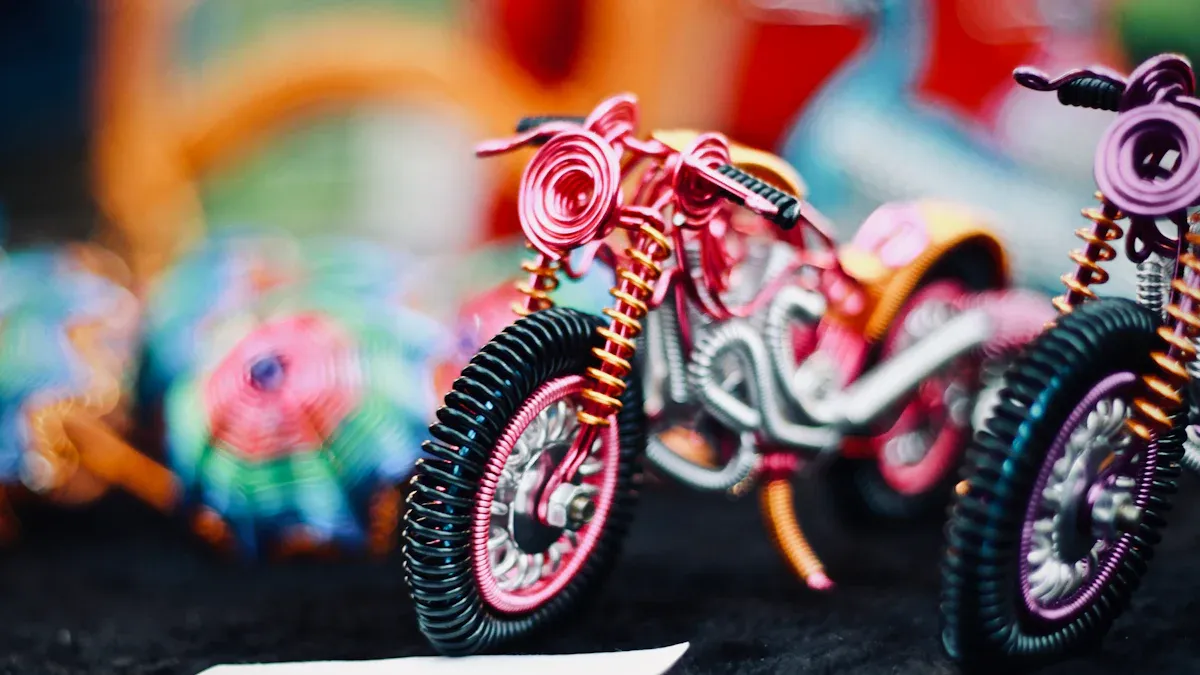Small Motors for Toys: How to Pick Right

When it comes to making toys move, spin, or perform tricks, the right motor is key. Small motors for toys come in all shapes and sizes, but not all will fit your project. Choosing a motor that matches your toy’s needs can make the difference between a fun gadget and a frustrating flop.
Key Takeaways
Pick the right motor type for your toy's purpose. DC brush motors work well for easy, short-term toys. Brushless motors are faster and last longer for advanced toys.
Think about power, voltage, size, and weight when choosing a motor. These factors help your toy run properly and fit its design.
Try out motors before making a final decision. Testing helps find problems early and makes sure the motor works for your toy.
Types of Small Motors for Toys

Toys can use two main motor types: dc brush motors and brushless motors. Each type has pros and cons. The best choice depends on your toy’s purpose. Let’s explore both options.
DC Brush Motors
DC brush motors are very common in toys. They are simple, cheap, and easy to use. These motors work by using brushes to send electricity to the rotor, which spins. This makes them great for basic toys like cars, tops, or small robots.
But there’s a downside. The brushes wear out over time, so these motors don’t last as long. They also get hotter and need more care. If your toy doesn’t need to run for hours, a dc brush motor could work well.
Here’s how dc brush motors perform under different conditions:
Voltage | Operational Lifetime (hours) | Observations |
|---|---|---|
4 V | Speed slowed after 8 hours, stopped working at 14 hours. | |
4 V | 17.5 | Worked better than the first motor at 4V but less than 5V. |
3 V | Not specified | Shorter life noticed when voltage increased. |
5 V | Not specified | Used as a baseline; higher voltages reduced motor life. |
If you’re on a budget or need a motor for a short project, dc brush motors are a good pick. Just watch for wear and tear.
Brushless Motors
Brushless motors are more advanced. Unlike dc brush motors, they don’t use brushes. Instead, they use electronic controllers to move the motor. This makes them quieter, more efficient, and longer-lasting.
Brushless motors are great for high speeds and quick movements. They’re ideal for toys like drones, fast cars, or advanced robots. They also need less care, which is helpful for long-term use.
Here’s a comparison of brushless motors and traditional motors:
Metric | Brushless Motors | Traditional Motors |
|---|---|---|
Efficiency | Higher efficiency, less friction and wear | Lower efficiency due to brushes |
Maintenance Requirements | Less care needed, no brushes | More care needed, brushes wear out |
Speed | Faster and quick to adjust | Slower and less adjustable |
Power-to-Weight Ratio | Better power-to-weight ratio | Lower power-to-weight ratio |
Lifespan | Lasts longer, less wear | Shorter life, brushes wear out |
Brushless motors cost more but are worth it for their performance. If your toy needs speed, precision, or durability, choose brushless motors.
Tip: Unsure which motor to pick? Think about your toy’s goal. For simple, short-term toys, dc brush motors are great. For advanced or long-lasting toys, go with brushless motors.
Key Factors in Motor Selection
Choosing the right motor for your toy is important. It helps your toy work well and last longer. Let’s look at what to consider.
Power and Voltage Requirements
Power and voltage are what make a motor run. They show how much energy the motor gives and how well it works. For toy motors, knowing these is very important.
Power comes from the voltage sent to the motor. Lower voltage means less power, which can affect how your toy works.
Motors have limits for voltage and current. Going over these can make the motor too hot or break it.
If a motor gets stuck or overloaded, it may stop working. Match the motor’s power needs with your toy’s battery size.
For example, a toy car needs a motor that handles quick moves without overheating. A spinning toy might need steady voltage but less power. Balancing power and voltage keeps your toy working smoothly.
Size and Weight Constraints
Motor size and weight matter for your toy’s design. A big or heavy motor can make the toy unbalanced or hard to move.
Think about the space inside your toy. A small robot needs a tiny motor that fits well. Lightweight toys like drones need motors that are strong but light. Brushless motors are good because they are small and efficient.
Always measure the space in your toy and check the motor’s size. This makes sure the motor fits and works properly.
Torque and Speed Considerations
Torque and speed are both important for motors. Torque helps your toy lift or move things. Speed shows how fast your toy can go. Picking the right mix of these is key.
For cars or robots, figure out how much torque is needed. This helps you choose a motor that can handle the weight. Linear motors are good for toys needing precise moves because they give steady torque.
Here’s a tip: If your toy needs to climb or push, focus on torque. If it needs to move fast, focus on speed. Knowing your toy’s needs helps you pick the best motor.
Compatibility with Toy Design
The motor must match your toy’s design. A wrong motor can make the toy work poorly or even break.
Think about the type of toy you’re making. Is it a drone, car, or robot? Each needs different motors. Drones often use brushless motors for speed, while small cars use DC brush motors for simplicity.
Also, check if the motor works with other parts like gears or wheels. Make sure it fits with the toy’s power source. Matching everything avoids problems later.
Pro Tip: Test the motor with your toy before deciding. This helps you find problems early and fix them.
By thinking about these factors, you can pick the best motor for your toy project.
Practical Tips for Choosing a Motor

Picking the right motor takes effort but avoids future problems. Use these tips to make a smart choice.
Test Motors for Performance
Testing motors before using them is very important. It helps you find issues early and ensures the motor fits your toy. Keep these points in mind while testing:
Crossed Switching: If using an H-bridge, don’t let both transistors on one side turn on together. This avoids short circuits. A microcontroller can add a small delay to help.
Key Components: Use NPN transistors for P-channel control. Check Gate voltage levels for MOSFETs.
Flyback Diodes: Place diodes across MOSFETs to stop voltage spikes.
Stall Current: Use a multimeter to measure stall current. Make sure it doesn’t exceed the driver’s limit, especially for bigger motors.
Did you know? Experts suggest using motion sensors to test motor performance in toy prototypes. This helps improve precision and ensures the motor meets your toy’s needs.
Read Motor Datasheets Carefully
Motor datasheets may seem confusing, but they’re full of useful details. They explain what the motor can and cannot do. Focus on these key points:
Overload Testing: Check if the motor can handle sudden resistance, like a toy car climbing a hill.
Thermal Testing: See how the motor performs under normal and extreme conditions. This prevents overheating during play.
Hydrokinetic Testing: For water-based toys, ensure the motor passes pressure tests for safety.
Reading datasheets carefully helps you avoid mistakes and pick the right motor.
Balance Budget with Performance Needs
Balancing cost and performance is important. Cheap motors might not last, but expensive ones can strain your budget.
Here are some tips to find the right balance:
Work with suppliers who offer good quality at fair prices. This helps you get reliable motors without overspending.
Use data to understand your toy’s needs. For example, if your toy needs stepper motors for precise moves, choose models that meet this need without extra features.
Pro Tip: Stepper motors are great for toys needing precise movements, like robotic arms or spinning devices. They provide excellent control and are worth the cost for advanced toys.
By testing motors, studying datasheets, and managing costs, you can pick the best motor for your toy. A little research now saves time and money later.
Picking the right motor for your toy takes some thought. Don’t just grab the first motor you see. Learn about the different motor types and how they suit your toy. Small toy motors differ in power, size, and how they fit. Testing and research can help you avoid errors and find the best one.
Here’s a quick look at how eco-friendly choices affect toy designs:
Aspect | Evidence |
|---|---|
Environmental Awareness | People like wooden toys more than plastic because they are renewable and break down naturally. |
Safety and Durability | Wooden toys are safer, last longer, and need fewer replacements. |
Educational Value | Wooden toys help kids think and be creative, which parents love. |
Take time to check what your project needs. A little planning now helps your toy work better and last longer.
FAQ
What makes DC motors different from servo motors?
DC motors spin continuously, while servo motors move to exact positions. Servo motors work well for toys needing precise control, like robot arms or steering parts.
How can I change how fast a toy motor spins?
Use a motor driver or controller to adjust the speed. For better control, try servo motors with feedback systems to fine-tune the velocity.
Can one motor handle many toy tasks?
It’s possible, but it depends on the motor’s torque, speed, and placement. For toys with many features, using different motors can improve how they work.
See Also
5 Essential Tips for Choosing a Small Vibrator Motor
Guidelines for Choosing the Perfect Vibrating Motor
Selecting Battery Operated Motors for Maximum Efficiency
Get Custom Micro DC Motors from
INEED Motors!
Leading Brand in Vibration Motor Manufacturing Industry
